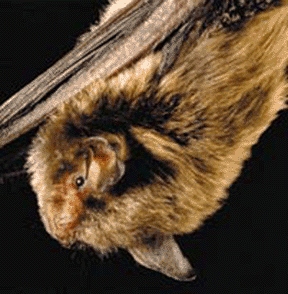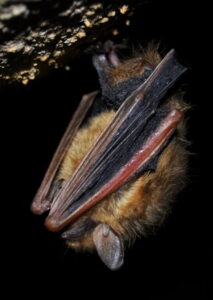Navigating the Forest of Federally Listed Bat Issues
Are you part of design, permitting, or construction of a project that impacts forested areas? Don’t let the bats make you batty! This article, prepared by GBA’s Environmental Business Committee, shares the latest information on the changing world of federally listed bat species.
Just like wetland regulations, this has been a tough realm to navigate lately. These are some general topics that can help us as geoprofessionals “navigate through the forest” of it all. This is not meant to be an “end-all” when it comes to working through specifics on a project, but hopefully it will help you develop a better understanding of the current status of this topic and allow you to ask more pointed and intelligent questions of an Endangered Species Act (ESA) practitioner and/or an experienced bat biologist.
The ESA regulations come to the table through a federal nexus, which can include federal permitting, federal funding, or any other federal involvement. Federal nexus falls under Section 7 for the ESA. In these circumstances, one should always start their project by visiting the United States Fish  and Wildlife Service (USFWS) Information and Planning for Consultation (IPaC) website: https://ipac.ecosphere.fws.gov/. This site generates an on-demand list of federally listed species upon entering an ArcGIS upload or a manually drawn sketch of the project area. Because the website is regularly updated to include refined range map data and other outputs, an IPaC-produced species list is considered outdated after 90 days.
and Wildlife Service (USFWS) Information and Planning for Consultation (IPaC) website: https://ipac.ecosphere.fws.gov/. This site generates an on-demand list of federally listed species upon entering an ArcGIS upload or a manually drawn sketch of the project area. Because the website is regularly updated to include refined range map data and other outputs, an IPaC-produced species list is considered outdated after 90 days.
In many regions, species covered by the IPaC Determination Keys (D-Keys) are federally endangered Indiana bats (IBAT), federally endangered northern long-eared bats (NLEB), and federally proposed endangered tricolored bats (TCB). Completing the D-Key process can produce an instant ‘may affect-not likely to adversely affect’ (NLAA) determination without having to contact a USFWS Field Office. This is the result you want for your project. However, it will more often produce a ‘may affect’ determination which requires more information by contacting the relevant USFWS Field Office. Each D-Key has a long series of questions that will not give a final determination without answering ‘Yes’ or ‘No’ to some of the following tougher questions:
• Does the action area contain any winter roosts or caves (or associated sinkholes, fissures, or other karst features), mines, rocky outcroppings, or tunnels that could provide habitat for hibernating bats?
• Will the action cause effects to a bridge?
• Will the action result in effects to a culvert or tunnel equal or exceeding 23 feet (7.0 meters) in length and 4 feet (1.22 meters) or greater in height at any time of year?
‘No’ answers to any of these questions sometimes require a survey report to be uploaded to continue. ‘Yes’ answers require a survey report to be uploaded before continuing in the D-Key. Therefore, early coordination through IPaC is imperative on projects with a federal nexus, especially projects with caves, mine portals, bridges, culverts, or forested areas.
The federal nexus automatically brings the USFWS to the table on a project, making this a voluntary process only if a federal nexus does not exist. Tree clearing restriction dates often appear in D-Keys in the form of a question making it easier to consult (instead of direct coordination with a USFWS Field Office and lag time awaiting a response). However, understanding a project proponent’s risk tolerance and priorities should always be addressed before deciding whether to consult. Some states have additional state-level restrictions/guidelines, so seeking out early guidance from a state agency (Department of Natural Resources, departments of environmental management/quality/protection, etc.) is also recommended.
Typically, an NLAA determination for bats can be achieved by clearing trees in winter (dates differ by state and region) if the area is not in the vicinity of a known hibernation site (hibernacula). However, if tree clearing during winter cannot be accomplished, a presence/absence survey can be conducted (generally May 15-August 15). The USFWS has established a year-round active portion of the NLEB and TCB in the southern U.S. parts of their range, allowing the USFWS to accept captures and/or acoustic detections of NLEB and/or TCBs collected March 1-October 15 (expanded from May 15-August 15) as traditional summer records. If no listed bat species are identified, trees can potentially be cleared any time of year for the next five years after the survey season.
(dates differ by state and region) if the area is not in the vicinity of a known hibernation site (hibernacula). However, if tree clearing during winter cannot be accomplished, a presence/absence survey can be conducted (generally May 15-August 15). The USFWS has established a year-round active portion of the NLEB and TCB in the southern U.S. parts of their range, allowing the USFWS to accept captures and/or acoustic detections of NLEB and/or TCBs collected March 1-October 15 (expanded from May 15-August 15) as traditional summer records. If no listed bat species are identified, trees can potentially be cleared any time of year for the next five years after the survey season.
The ranges of TCB, NLEB, and IBAT overlap considerably across the eastern United States, where all three species can be found cohabitating. However, TCBs also occur in portions of the western U.S. (e.g., Texas, Colorado, New Mexico, etc.) that are dominated by forest-limited landscapes, such as grasslands. Tree clearing restrictions on projects in areas outside the IBAT range are likely to be new to most project proponents in those areas.
Little brown bats are expected to be evaluated for listing in 2026, and a listing decision date for TCB had not been established or announced at the time of this posting.